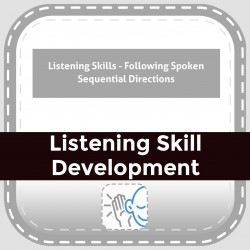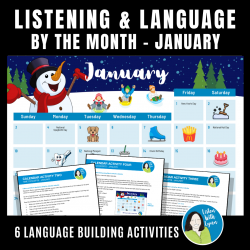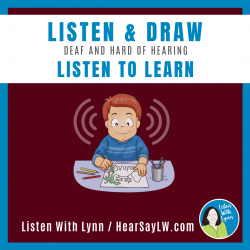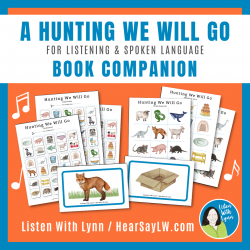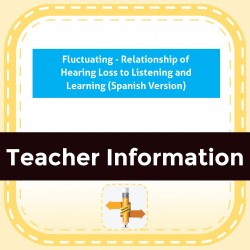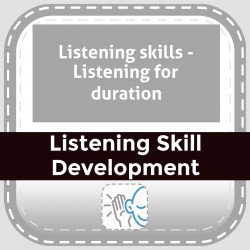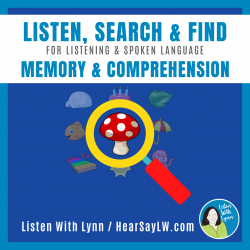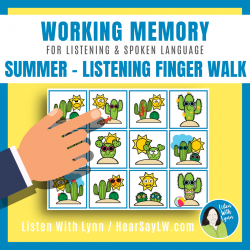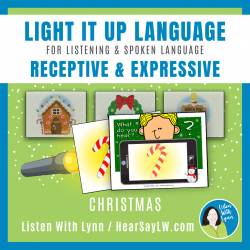Ability Levels
Categories
Resource Types
Age/Grade Range
CCSS
Anchor Standard
Speaking & Listening
Language
Reading
Listening Skills - Following Spoken Sequential Directions
$ 195
This
article has tips for teachers giving directions and steps for students to
practice to improve their ability to follow directions. It has 4 'listen and
do' activities.
...
JANUARY Listening Vocabulary Comprehension
$ 5
The Listening and Language By The Month resourcesare so much more than calendars! They include seven activities that each can be used ALL MONTH for auditory memory and comprehension, seasonal vocabula
...
ocabulary, developing grammar, and building conversational skills.IDEAL FOR: Listening & Spoken Language, Deaf & Hard of Hearing, Speech, ELA, Teletherapy, Distance Learning, Print and DigitalWork smarter, not harder by strategically including ongoing calendar activities all year long while growing listening, building language, literacy, and academic skills.Time concepts are taught, learned, and understood with repetition and practiced over time. The calendar lessons included are based on years of working with children who are deaf and hard of hearing and guiding their families.Each month includes seven listening and spoken language activities or mini-lessons each month.Create an experience-based calendarListen and follow directionsAuditory comprehensionAuditory Inferencing using a featured child's calendar each monthCalendar Conversations Barrier GameAuditory comprehension and integration - Fun Facts about the monthMake your own calendar. Perpetual calendar activityIncludes✢ A guide for growing vocabulary and time concepts and instructions for using these activities✢ Listening and Spoken Language Tips✢ Engaging activity calendars with rich vocabulary and colorful imagesTeletherapy, Distance Learning & Face to Face✧ Print version or digital✧ Interactive PDF - No Print version can be opened and played with your favorite PDF reader app on a tablet. When playing on a computer, open and use a PDF reader such as Adobe Acrobat Reader DC which is free.★ ★ ★ Take it easy while providing amazing lessons and sessions just like these therapists and teachers!➼ Jennifer said this resource was fun for my students and their families to use together. Not only was I able to target the concepts mentioned, but there were also many opportunities for additional vocabulary/language learning that came up while using this resource.➼ Bridget wrote, This is my 3rd month and I will be buying this calendar all year. Love the variety of activities. I’m using it with my ENTIRE caseload of 4 - 13-year-olds.➼ Deirdre said I would give you 100 stars if I could! I love these calendars and will be buying all of them!!◈ ◈ ◈ ◈ ◈ ◈ ◈ ◈ ◈ ◈ ◈ ◈ ◈ ◈ ◈ ◈ ◈ ◈ ◈ ◈ ◈ ◈ ◈ ◈ ◈ ◈ ◈ ◈ ◈ ◈ ◈ ◈ ◈ ◈CUSTOMER TIPS:➯ Questions? Feel free to email me before purchasing this resource or anytime later.➯ Sign-up HERE for the Listen With Lynn NewsletterKeep up your good work. I am blessed to help along the way. Thanks so much!LynnLet’s Connect:InstagramFacebookPinterestHearSayLW.comHearSayLW BlogTwitter
Self-Advocacy Listen & Draw Directions DHH
$ 3
LISTEN TO LEARN is the eighth in the popular Listen & Draw series. These are all auditory imagery activities that target following directions while growing vocabulary, memory and sequencing skills. De
...
etails can be easily simplified or information added to increase the complexity to match the child’s listening and language goals.Children listen to detailed descriptions then follow the directions and draw four different young students all of which are deaf or hard of hearing and use hearing technology. A couple of the kids could be better listeners which is both entertaining and learning opportunities for the kids.Isabella hears with two cochlear implants.Watson hears with two hearing aids.Bryn hears with a Baha® device.Noah hears with a hearing aid in his left ear and a cochlear implant on the right. This LISTEN TO LEARN activity also targets self-advocacy skills. Talking through each scenario will encourage your students to understand the importance of listening to learn and be successful at school.Listening and Spoken Language (LSL) tips are included to encourage auditory learning.
A HUNTING WE WILL GO Listening, Language, & Literacy Book Companion
$ 6
Oh, A-Hunting We Will Go is my favorite rhyming story and song for growing listening, language, and literacy with preschoolers and early elementary-aged children. I have included it for years as part
...
part of my Thanksgiving thematic unit. The playfulness of the song with the repetitive verses and humorous well-loved warm illustrations can help children develop early spoken language and literacy skills, such as auditory discrimination, phonological awareness, vocabulary development, and auditory memory.This companion gives you a variety of hands-on games for children with hearing loss and those with typical hearing to practice listening for, recognizing, and producing rhymes. I love helping therapists and teachers instill a love of shared book-reading that has kids engaged and excited.This book companion was created to be used with the popular folk song, Oh, A-Hunting We Will Go by John Langstaff and illustrated by Nancy Winslow Parker. The activities correspond with the style of the book's illustrations.Three Games* for listening for, recognizing, and producing rhymes.1. Go Turkey - (24) playing cards2. Rhyming Lotto - (8) Lotto cards3. Rhyming Dominos - (45) dominos*The games are not visual matching games rather players ask for rhyming pairs. (Example: I have a snake. Do you have a card that rhymes with snake?)WHAT'S INCLUDED:Listening and Language Guide3 Games with charming graphics5 Happy Hunting extension activitiesListening & Spoken Language (LSL) TipsEASY ONE-TIME PREPPrint and cut out the games and Lotto boards. Done.PLEASE NOTE: A physical copy of the book Oh, A-Hunting We Will Go by John Langstaff and illustrated by Nancy Winslow Parker is not included in the digital download. The public library or Amazon, Thriftbooks, eBay are great places to look for a copy.◈ ◈ ◈ ◈ ◈ ◈ ◈ ◈ ◈ ◈ ◈ ◈ ◈ ◈ ◈ ◈ ◈ ◈ ◈ ◈ ◈ ◈ ◈ ◈ ◈ ◈ ◈ ◈ ◈ ◈ ◈ ◈ ◈ ◈LET'S CONNECT:★ Sign up HERE for the Listen With Lynn emailsInstagramFacebookKeep up your good work. I am blessed to help along the way.Thanks so much!Lynn Wood
Fluctuating - Relationship of Hearing Loss to Listening and Learning (Spanish Version)
$ 0
Handout with information on possible impact on understanding language, speech, social, and need for educational accommodations and services in Spanish language. For 16-25dB or minimal hearing loss.
...
Listening skills - Listening for duration
$ 0
Duration, in the context of listening, consists of an awareness of the length of sounds. Duration awareness impacts every aspect of listening. These instructional strategies include ways to support d
...
uration awareness.
LINK IN A WINK VOCABULARY and ATTRIBUTES Listening, Language Game
$ 6
LINK in a WINK is an exciting fast-paced vocabulary game designed to support listening and spoken language development. Kids love this fun, easy-to-play game, all while expanding their vocabulary, lea
...
, learning attributes, and practicing categories, associations, auditory memory, word retrieval, and turn-taking skills.This game also strengthens important cognitive abilities, such as working memory, abstract reasoning, and cognitive flexibility, especially for children who are deaf or hard of hearing.★ No Planning! One Time Print. Then Grab-N-Go!★ Use all year round and year after year!The Object is to listen and be the first to find a PICTURE card from their hand that matches the ATTRIBUTE word or phrase.HUGE RESOURCE! What’s Included:✧ 100 Attribute Cards✧ 120 - 60 Two-Sided Picture Cards✧ Instruction Guide✧ Listening and Spoken Language TipsIdeal For: Therapy sessions, small group lessons, or fun at home. Deaf & Hard of Hearing, Listening & Spoken Language, Auditory Verbal Sessions, Speech Therapy, Special Education, Home LearningThe Object is to listen and be the first to find a PICTURE cardfrom their hand that matches the ATTRIBUTE word or phrase.WHY Teach Attributes? Targeting attributes is essential in vocabulary development and language acquisition for several reasons:✤ Expands Vocabulary:Introduces descriptive words to broaden a child's lexicon.✤ Enhances Word Retrieval:Strengthens mental connections, making it easier to recall words.✤ Boosts Descriptive Skills:Focusing on specific attributes to help children describe items with greater clarity and precision.✤ Improves Writing:A richer vocabulary enhances written expression, making it more varied, and easier to understand.STAY CONNECTED:➼ Any questions?? Email me directly at ListenWithLynn@gmail.com before purchasing this resource or anytime later.✧ Sign-up here for the Listen With Lynn emails✧ Follow on Facebook - Lynn A. Wood - LSL Auditory Verbal Therapist and Rehab Audiologist✧ Follow on Instagram @auditoryverbal_listenwithlynn❤ Keep up the excellent work—it's a blessing to be part of your journey. Thank you so much!Lynn Wood
LISTEN, SEARCH AND FIND - Auditory Memory & Comprehension
$ 12
Listen, Search and Find is a digital auditory memory and comprehension resource and features interactive listening and spoken language activities for auditory learning and practice. This is a huge 134
...
134-page resource that has four decks with navigation that moves from page to page with clickable pictures.The object is to listen, recall, comprehend, search and find the picture on each game slide from a large closed set of 50 items. The interactive PDFs keep listeners active and engaged. The therapist, teacher or parent reads the provided prompts. The Prompt and Data Collection Sheets are downloadable for easy access.This resource works great for screen sharing on a computer in teletherapy and played face to face on a computer, tablet, or smart board. It is easily printed and played in person with no technology.What's included:Huge 134-page resource4 Game decksPrompts with answersData collection sheetsListening and Spoken Language TipsTerms of UseDECK 1: Auditory Closure is completing a short close passage presented auditorily.The goal is for the listener to complete the sentences by filling in the missing words.This targets auditory association, discrimination, word retrieval, and long and short-term memory skills.Example: The black widow spider is spinning a _________. WebDECK 2: Auditory Integration involves recalling keywords presented auditorily.The goal is to identify keywords in each sentence. The listener processes information read aloud then answers a question about the sentence.Example: Rabbits are fast and turtles are slow. What animal is slow? TurtleDECK 3: Auditory Directions involve following a series of verbal directives presented auditorily.The goal is to listen to multi-step commands then perform each task in order.Example: Blink your eyes 3 times, find the igloo then pretend to shiver. IglooDECK 4: Listen For Inferences is drawing logical conclusions based on 4-part riddles presented auditorily.The goal is to make logical guesses and identify pictures by listening to four clues. Each of the clues is increasingly more specific.Example: I am alive.I am often green but some change colors.I am a flat part of a plant.I grow.Leaf➼ DIGITAL - NO PRINT can be opened and played with your favorite PDF reader app on a tablet. When playing on a computer, open and use a PDF reader such as Adobe Acrobat Reader DC which is free. ➼ PRINT - Print out a game card and use Bingo chips as markers.Please note: The Listen, Search and Find resources are serve and return conversational games between the adult and the listener. I have been asked if the game includes an audio component that would allow the child to play independently. There are no sound bytes included.◈ ◈ ◈ ◈ ◈ ◈ ◈ ◈ ◈ ◈ ◈ ◈ ◈ ◈ ◈ ◈ ◈ ◈ ◈ ◈ ◈ ◈ ◈ ◈ ◈ ◈ ◈ ◈ ◈ ◈ ◈ ◈ ◈ ◈CUSTOMER TIPS:➯ Questions? Feel free to email me before purchasing this resource or anytime later. ➯ Sign up HERE for the Listen With Lynn NewsletterLet’s Connect:InstagramFacebookKeep up your good work. I am blessed to help along the way. Thanks so much!Lynn
SUMMER Working Memory FIVE Listening Finger Walk Games
$ 5
Summer Listening Finger Walks are a must-have for kids that need help with auditory working memory, executive functioning, and following directions.Working memory plays a big role in how we auditory p
...
ry process, follow, and remember information on a daily basis. Working memory is one of the brain's executive functions. Children and teens who have a hard time “staying on track” might have problems with something called working memory.Ideal For: Listening & Spoken Language, Executive Functioning, Deaf & Hard of Hearing, Auditory Processing, Speech, Auditory Verbal Therapy, ELA, Teletherapy, Home...Listening Finger Walks are FUN for the kids and SIMPLE for you!These 5 No-Prep activities are ideal all winter long with fun themes for therapy sessions or school lessons.➯ The FIVE Listening Walks can help build listening skills and working memory by allowing kids to work with auditory information without losing track of what they're doing.➯ The games target vocabulary, descriptive skills, spoken language, and communication skills.➯ Each of the five games has three rounds that increase in auditory complexity.Five Listening Finger Walk Games✧ Summer Action Verbs & Activities✧ Ice Cream Cones✧ Under the Sea✧ Cactus Plants✧ Summer FunGame PlayYou need one listening game sheet per child.The child listens and follows verbal directions while walking their fingers around the grid until they hear STOP. They are using their working auditory memory to follow the directions without losing track of what they were doing.Then, ask them to describe that block which is a great language expansion opportunity.If correct, they landed on a specific image and completed that round.Let the child take turns giving you the directions. This helps build expressive language and turn-taking skills.Game Prep Print Version: Easy one-time prep. Print the five-game cards and laminate them if you wish.No Prep - Digital Version: Play on a computer with your favorite PDF reader app or on a tablet. When playing on a computer, open and use a PDF reader such as the free Adobe Acrobat Reader DC. The child uses their finger or the annotation tools to mark their walking path on the game cards.Please Note: This activity and the SUMMER FOUND IT! resource contains many of the same summer images that are bright, enticing, and vocabulary rich.However, these two resources target completely different auditory and language-based goals.You will want both resources you will want in your Summer Toolbox.FACE TO FACE - TELETHERAPY - HOME✢ PRINT - One-time easy prep and use time and time again✢ DIGITAL - The games can be opened and played with your favorite PDF reader app on a tablet or iPad. Tokens can be placed directly on the screen. On a computer open the PDF game boards with a PDF reader such as Adobe Acrobat Reader DC which is free.◈ ◈ ◈ ◈ ◈ ◈ ◈ ◈ ◈ ◈ ◈ ◈ ◈ ◈ ◈ ◈ ◈ ◈ ◈ ◈ ◈ ◈ ◈ ◈ ◈ ◈ ◈ ◈ ◈ ◈ CUSTOMER TIPS:➼ Questions? Email me before purchasing this resource or anytime later.♥ Sign-up HERE for the Listen With Lynn Newsletter♥ Let's connect on Facebook and Instagram♥ For more ideas visit my blog: HearSayLW.comKeep up your excellent work. I am blessed to help along the way.Thanks so much!Lynn Wood
CHRISTMAS Auditory Processing Receptive & Expressive Language Game
$ 5
You'll love the Christmas version of Light It Up Language! Kids listen to clues to identify 16 hidden holiday vocabulary pictures. This engaging activity targets auditory memory, comprehension, proces
...
essing, and receptive and expressive language skills.The magic happens by lighting up the “What Do You Hear?” cards. Hidden pictures are held up to a flashlight and the Christmas images amazingly appear. How fun!TARGETS: RECEPTIVE: This game builds critical thinking and reasoning skills by categorizing, making inferences, and drawing conclusions. EXPRESSIVE: Once the hidden picture is revealed the child recalls and uses the clues to describe the object. Thereby, stretching their auditory memory, descriptive language, and expressive language skills.INCLUDES:✧ Listening & language guide with instructions✧ Target or goal suggestions✧ 8 What Do You Hear? cards (printed twice)✧ 16 Christmas Hidden Object Picture Vocabulary Cards✧ 64 Prompt Clues - 16 objects with four details each that get increasingly more specific✧ A Script with scaffolding strategies✧ Listening and Spoken Language TipsEASY one-time quick game prep and you're all set year after year.You’ll need a flashlight, a lamp, or a sunny window.◈ ◈ ◈ ◈ ◈ ◈ ◈ ◈ ◈ ◈ ◈ ◈ ◈ ◈ ◈ ◈ ◈ ◈ ◈ ◈ ◈ ◈ ◈ ◈ ◈ ◈ ◈ ◈ ◈ CUSTOMER TIPS:➼ Questions? Email me before purchasing this resource or anytime later.♥ Sign-up HERE for the Listen With Lynn emails♥ For more ideas visit my blog: HearSayLW.comSTAY CONNECTED:✧ Sign-up here for the Listen With Lynn emails✧ Follow onFacebook - Lynn A. Wood - LSL Auditory Verbal Therapist and Rehab Audiologist✧ Follow on Instagram @auditoryverbal_listenwithlynn❤ Keep up your excellent work. I am blessed to help along the way. Thanks so much!Lynn Wood
 Your browser is out of date. For best experience switch to latest updated Browser.
Your browser is out of date. For best experience switch to latest updated Browser.
 Get Chrome
Get Chrome Get Edge
Get Edge Get Firefox
Get Firefox